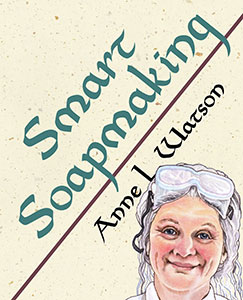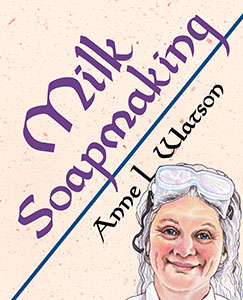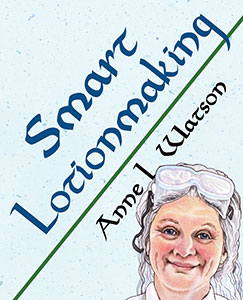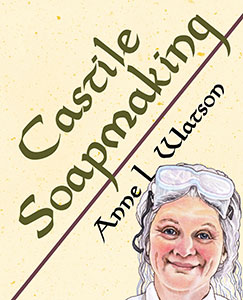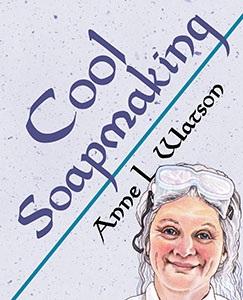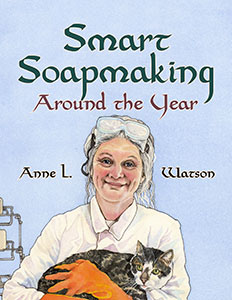The Modern Way to Make Soap from Scratch!
Smart Soapmaking
The Simple Guide to Making Soap Quickly, Safely, and Reliably
OR
How to Make Soap That’s Perfect for You, Your Family, or Friends
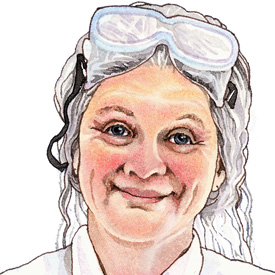
By Anne L. Watson
Illustrated by Wendy Edelson
Listed in “References & Resources” for Certification Level 1 of the Handcrafted Soap & Cosmetic Guild
General Info
Reviews and Comments
Contents
Sample Text
Maybe you’d like to make your own soap, but you’re worried that working with lye is too difficult or dangerous. Maybe you’re scared off by “beginner” books that go on for hundreds of pages and leave you less confident than before. Or maybe you’re already making soap, but you wonder if methods you’ve learned are slower and more complicated than they need to be.
Whether beginner or advanced, you’ll find Smart Soapmaking practical, helpful, and refreshing. Written by a former professional soapmaker, it explodes the myths about soapmaking and shows you how to make wonderful soap from scratch with the least fuss and bother.
You’ll get a wide variety of recipes, plus you’ll learn how to modify them and create new ones. Want to make a luxurious gift soap? Or one that’s all natural, with no artificial ingredients? Maybe a moisturizing soap for dry skin? Or one with a trending oil not yet in books? With Smart Soapmaking, you can do all that and more, to get exactly the soap you want.
Anne L. Watson is the first author to have introduced modern techniques of home soapmaking and lotionmaking to book readers. She has made soap under the company name Soap Tree, and before her retirement from professional life, she was a historic preservation architecture consultant. Anne and her husband, Aaron Shepard, live in Bellingham, Washington.
Shepard Publications
Paperback ~ 2007
Ebook ~ 2013
Digital Download (PDF) ~ 2025
The following links may earn commissions for this site.
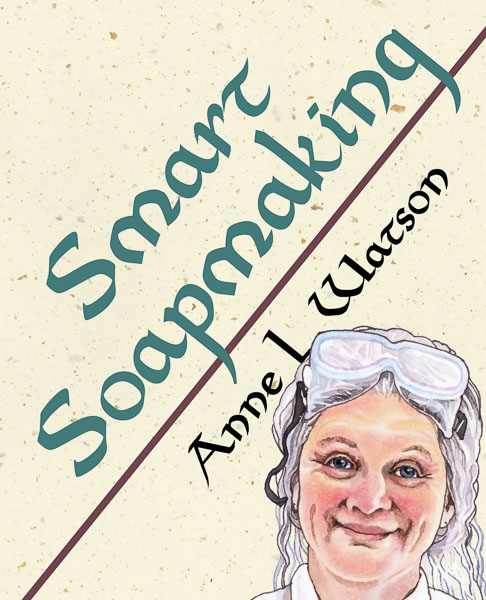
“The only book [you’ll] ever need.”—Mother Earth News, Feb.–Mar. 2019
“Should become the book for soapmaking. . . . It’s about time someone wrote a book like this. Most are idealistic and inaccurate. This book has a wonderful common sense approach that is SO long overdue. . . . I can recommend it with 100% confidence.”—Susan Kennedy, Oregon Trail Soaps, Rogue River, Oregon
“Smart it is . . . . A simple, no‑nonsense book that cuts through the curmudgery of stifling soap bibles like no other.”—Shellie Humphries, Harstine Island, Washington
“Quick, safe, and reliable. . . . As fun as it is informative, Smart Soapmaking is a must for anyone who would like to try their hand at this traditional craft.”—Library Bookwatch (Midwest Book Review), Jan. 2007
“Way overdue. . . . A gift of common sense caution, proven methods, tried-and-true shortcuts, and some excellent recipes as well, for both the professional/experienced soapmaker and the eager beginner.”—Deb Petersen, Shepherd’s Soap Co., Shelton, Washington
“A great book for beginners, with clear and easy instructions.”—Anne-Marie Faiola, Bramble Berry Inc., Bellingham, Washington
“I learned more from Smart Soapmaking than from any other soaping book, and I have read quite a few. . . . It’s written with the average person in mind, not a chemistry major. Directions are very simple and easy to understand. It really takes the mystery out of making soap.”—Jackie Pack, Stuart, Virginia
“Written in an easy, casual style that reminded me of an in‑person soapmaking class. The information is practical, helpful, and easy to understand.”—Barb Miller, Miller’s Homemade Soaps, Westfield, Pennsylvania
“Excellent . . . . The simplicity and fear quashing is wonderfully reassuring to the beginning soaper.”—Kerry Pearson, Heirloom Body Care, Llandilo, New South Wales
“The directions are more practical than in other soapmaking books I’ve read. I was also happy to see how many great sources for materials and information the book provided. The book will save soapmakers a lot of time and effort.”—Pamela Paine, Butternut Creek Farm Soaps, Dorset, Ohio
“Written with a delightful voice and humor.”—Kathy Miller, Miller’s Homemade Soap Pages, Silverdale, Washington
“I wish Smart Soapmaking had been my first book on soap. It simplifies the process, and it just makes sense. . . . Covers several months worth of questions.”—Phyllis Driggs, Liberty, Indiana
“Excellent . . . . Easy to read, practical, down to earth. Performs the greatly needed service of dispelling myths, which it does with a sense of humor.”—Loretta Liefveld, Nature’s Wild Child, Rancho Cucamonga, California
“A necessity for those just starting out who want to do it right from the very first time.”—Megan Baillie, Budd Lake, New Jersey
“BRILLIANT to find the recipes are in grams as well as ounces.”—Jude Birch, Aussie Soap Supplies, Bicton, West Australia
“A must for anyone who would like to try their hand at this traditional craft. . . . An ideal manual that is as fun as it is informative.”—Midwest Book Review, Jan. 2007
“After making soap for the past year, worrying about every little step and superstition, it was very entertaining and reassuring to read Smart Soapmaking.”—Jocelyn Gilmartin, Alisei Soap, Oldwick, New Jersey
“I used Smart Soapmaking to make my first batch of soap. And it was easy!”—Donna McGinn, Pequea, Pennsylvania
“I wish I had read this book six batches ago! I feel like I can start over and make great soap easily.”—Sue Turgeon, South St. Paul, Minnesota
“As a long time soapmaker, I can highly recommend this book and wish that it had been written when I was first starting out . . . . Walks you through from start to finish in a logical and practical way, whether you are new to this wonderful world of soapmaking or have been doing it for years.”—tenzicut, Down to the Roots Magazine
“Anne explains the basic tools and steps of soap making better than any basic book on the market today—and in doing so, dispels many of the old‑time myths and fears of soap making.”—David Fisher, About.com: Candle & Soap Making • Read the whole review •
“The simplest, most delightful book on soapmaking. . . . . I read it in two days and was ready to buy my soapmaking supplies.”—Theresa Powers, Joyous Home, Castle Rock, Colorado
“Groundbreaking . . . . Anne L. Watson [is the] universally respected and loved author/crafter/curator of this lost art for thousands of aspiring soapers . . . . Unquestionably the best book with which to begin. To be precise, it’s probably the most accessible, most reader-friendly, and most immediately useful container of information a first‑time soapmaker could hope to find.”—Wishing Willow (blog)
“Smart Soapmaking finally got me over the hump [of fearing lye]. . . . I think Anne Watson is the Elizabeth Zimmermann of the soap world—a frugal, common sense gal, who says, ‘Don't overcomplicate things. Just make soap.’”—Amanda Blake Soule, author, The Creative Family and Handmade Home, Soule Mama (blog), Feb. 7, 2012
“This is the book I wish I had read first, years ago. Anne explains the basic tools and steps of soap making better than any [other] basic book on the market today—and in doing so, dispels many of the old‑time myths and fears of soap making. . . . Simply written and illustrated, with a deep experience and wisdom infused through every page.”—David Fisher, About.com
One thing that puzzles new soapmakers is instructions to stir your soap mixture till it shows a condition called trace. This is described as when the mixture is so thick that, if you dribble a bit of the mixture back into the pot, a “trace” of what you dribble will remain on the surface.
Beginning soapmaking books often contain close‑up photos of soap at trace. I remember squinting at many of them, trying to figure it all out. When I started making soap, I made two successful batches, fretting about trace the whole time. The soap came out fine, but I was sure I was doing something wrong. I hadn’t seen anything that looked like the photos.
It was my good luck to have a friend who had been a high school chemistry teacher. When I phoned and told her about my difficulties with trace, she asked what it was. I was surprised a chemist didn’t know, but I explained as best I could.
There was a brief silence. Of course I couldn’t see her, but she was probably rubbing her forehead—which she does when anyone says something that makes no sense.
Finally, she said, “You don’t need to worry about that. If you just measure correctly, control the temperature, and mix your ingredients well, you’ll get soap.”
I decided to follow her advice, and I’ve never lost a batch of soap. Follow mine, and you won’t either.
But why the difference? Are all those soap books wrong?
Not really. With hand stirring, you do have to look for trace. That’s because saponification—the chemical reaction that creates soap—has to thicken the mixture to that point before you can stop stirring and pour it into the mold. Otherwise, some of the fat and the lye solution could still separate, leaving the reaction incomplete.
But in modern craft soapmaking, hand stirring is most often replaced by use of a stick blender. This blends the fat and the lye solution so rapidly and thoroughly that they quickly get mixed down to a microscopic level. That not only gets the mixture saponifying a whole lot faster, it also helps hold the fat and the lye solution together while it’s happening.
Of course, the chemistry is more complicated than that, but the bottom line is that you don’t have to wait for the mixture to thicken all the way to trace before pouring it into the mold. It will get there after you pour it.
How do you know when you can stop blending? Don’t worry, I’ll describe the signs for you. You’ll be able to tell by sight, by sound, and even by temperature. Yes, you’ll be able to gauge it with a thermometer!


